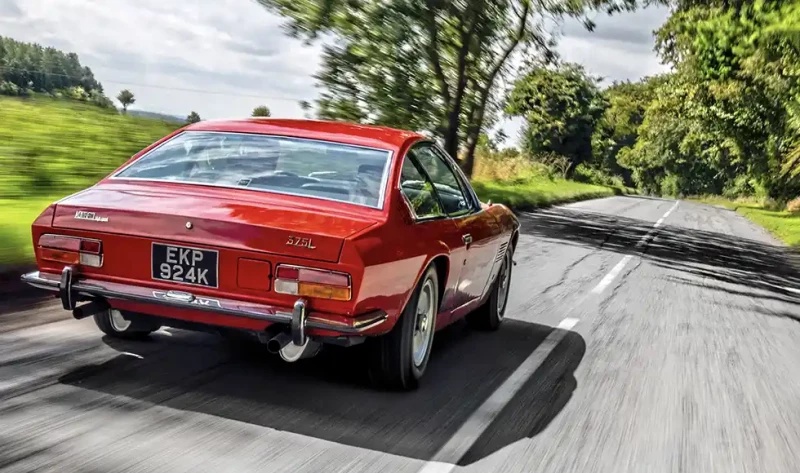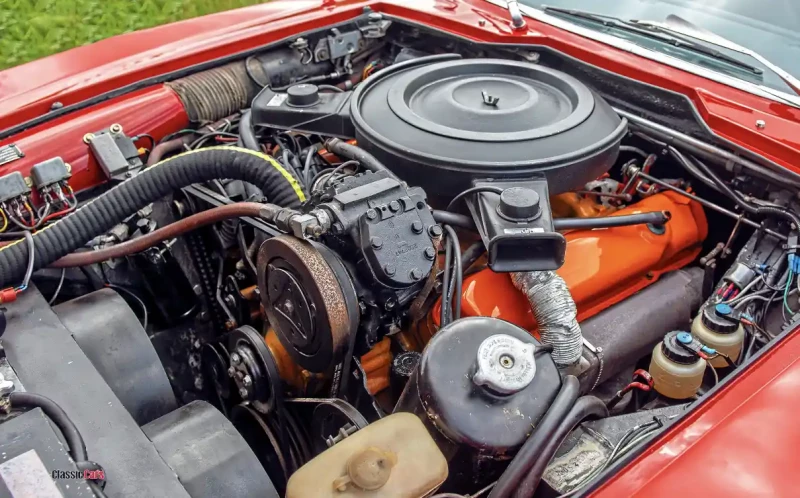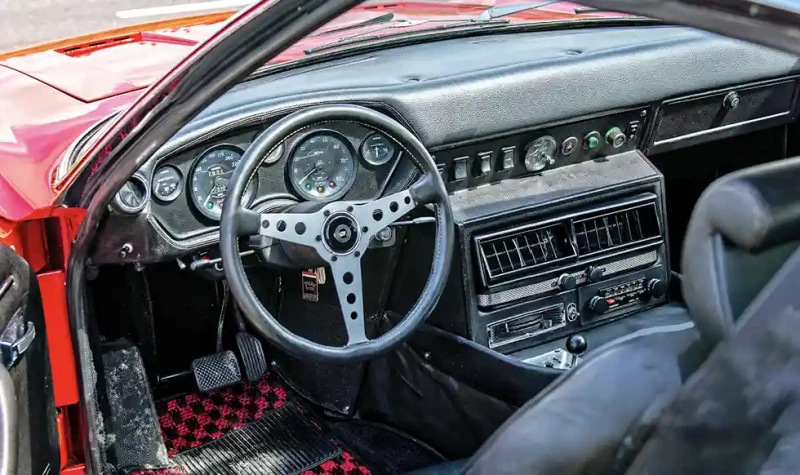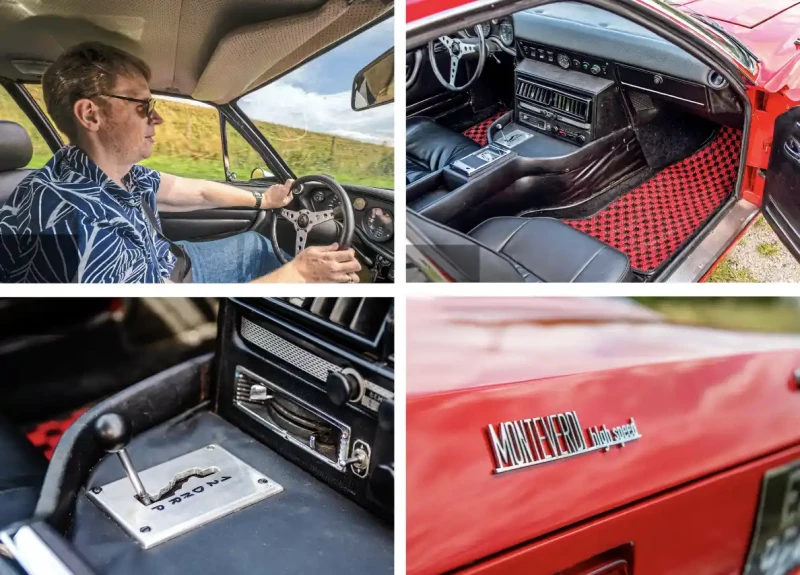1971 Monteverdi 375L HS
The Full Monte Monteverdi spectacular: UK road test, Alpine trip, and interview with the founder’s right-hand-man, Paul Berger.
Monteverdi plucked from the Alps
Test drive, Swiss adventure, and a Monteverdi insider tells all
Life’s no piece of cake, mind you, but the recipe’s my own to fool with,” the Japanese author Haruki Murakami once said. It comes to mind when taking in the bright-red form of the Monteverdi 375L High Speed. After all, if you wanted a big-engined hyper GT in the Sixties and Seventies, you had plenty of choice from Aston Martin, Lamborghini, Ferrari and Maserati, and that’s before you delve into transatlantic concoctions from the likes of Gordon Keeble, Iso and Jensen. Choosing a Monteverdi, then and now, might be seen as an irrational choice given the talents available elsewhere – especially because the 375L was much more expensive than any of them. A Ferrari Daytona would cost you a third less.

With the 440ci Chrysler V8 almost effortlessly pulling with the luxuriant growl of a resting lion and the three-spoke, leather-trimmed alloy wheel sharply responding to my fingertip inputs, it all seems remarkably rational, to the point that I’m wondering whether those big names and their oft-repeated virtues owe more to their badges than their driving abilities.
The story of Monteverdi’s cars is borne of rationality too. That might seem odd, seen through the modern prism of a dozen or so failed supercar start-ups that come and go almost by the time you’ve read the hastily written press releases, but the foundations of this car come from stark lateral thinking. By the early Sixties, former racing driver Peter Monteverdi had developed his craft from building one-off racing specials to becoming Switzerland’s leading BMW, Lancia and Ferrari importer, alongside selling other high-end marques. The germination of the project came in 1963, when Enzo Ferrari issued Peter with an ultimatum – pay for 100 cars up front or lose the importing rights. Such a figure was far beyond what Monteverdi could countenance and anyway, Maranello’s machines were proving to be awkward for his customers. In a conversation that must have required some brass neck, he laid it out for Enzo – his largely older customers loved the speed, styling, sound and handling of Ferraris; they were markedly less keen on calf-burning clutch pedals, bicep-straining gearshifts and for their cars to regularly take unplanned sabbaticals from onward movement. While a failure to proceed is annoying everywhere, engine failure up the Simplon Pass simply wouldn’t do. These customers were used to the reliability of a Swiss watch.

‘The Monteverdi does a fine job of being a car, rather than a racing machine with badges’
Of course, there’s a marked difference between a cultured Ferrari V12 and the cubic-inch overload of a Detroit V8, but as I start to press on a bit, the Monteverdi does a fine job of being a car, rather than a racing machine with badges. In Ferrari’s defence, in the time lag between Monteverdi’s grand plan and production car reality, the Mike Parkes-developed 275GTB came along, revolutionising Ferrari road car behaviour with its independent rear suspension. It was only available as a manual. I don’t feel particularly short-changed with such a long-legged V8; for all of the sonic qualities of a Ferrari V12, if you just want to get somewhere quickly, the Monteverdi’s far-off V8 burble is a more relaxing travel companion on a long journey.
Such details show Monteverdi’s vision; he called Ferrari’s bluff and gave up the concession, and set about creating the precise car his customers wanted, Pietro Frua penning a stunning body, with the robust might of Chrysler to provide motive power. The resultant High Speed – why be coy? – 375 S appeared in 1967, a sharp-suited riposte to Maranello that evoked Maserati cues.

Its construction was convoluted – the suspension and drivetrain were built at Monteverdi’s workshops in Binningen, Switzerland onto chassis made by Monteverdi-owned Stahlbaue AG in nearby Muttenz. This basis was then trucked to Frua in Turin to have the body applied and most of the finishing done. The package was then returned to Monteverdi for final detail work prior to delivery. Under the skin, apart from the Chrysler drivetrain, Monteverdi used trusted British suppliers like Maserati had done with its 3500 and Sebring. Front suspension was from Alford & Alder, rear axle a Salisbury unit and four-wheel disc brakes by Girling. However, the unassisted steering was from ZF, fed with a Chrysler-supplied oil cooler.
The arrangement with Frua would last 12 months, during which time only around six to ten cars had been built; Monteverdi wanted to increase production to 100 cars per year, far beyond what Frua could handle. It would lead to a falling out, with Monteverdi withholding royalties. The resultant court case saw the Swiss firm having to come up with a fresh design, unable to sell anything with a Frua body. Production moved to Fissore and the car was adapted into a 2+2 layout at the request of customers. The High Speed 375L was born, and over the next seven years between 60 and 100 examples of all kinds (S, L, C and /4) would be built; nobody has established precise figures. With such an eye-popping exterior, you might be counting on an exuberant interior. Sadly, it’s not – funereal black leather abounds and while the dials are clear, there’s a lack of artistic flair compared to its contemporaries. And it’s an odd driving position with the gear selector encroaching on knee and steering wheel space. This car has hand-written gear selection notes – the original item apparently melted, and replacements are hardly plentiful from EuroCarParts. The second strangeness is the seating position with legs and feet pointed straight out, and your back upright. It feels racy – perhaps understandable, given Peter Monteverdi’s competition background – but with the steering wheel such an arm stretch away, and the cut-out space for the gearshift, it’s like trying to wriggle yourself into a business class cabin; spacious, but a bit awkward.

Once in, the rewards are instant. As the 380bhp, 7.2-litre Magnum V8 thrums into life, figures pop in and out of the mind: the 375L can surge to 100mph in a smidge under 11 seconds after kissing goodbye to 60mph around three seconds prior. All out it could crack a 150mph, delivering on its name. While from the outside there’s the familiar Detroit baritone, inside the refined 375L it all sounds somewhat detached, far down the enormous bonnet. There’s supposedly at least 100kg of sound-deadening in each car; indeed, Peter Monteverdi once said that his greatest rival was Rolls-Royce rather than Ferrari. Demand action however, and the 375L wakes up, raising the nose with a deep-lunged growl. Peak power is delivered at 4600rpm with the redline not much higher; 480lb ft of torque is delivered at 3200rpm. Even without the Torqueflite three-speed automatic dictating matters, this is not an engine for chasing redlines, more for punching holes in overtaking space.
So far, so High Speed. But don’t go thinking this is a straightline hero, corner-zero car. Again, it all comes to down to being rational. While there’s no doubting that the racing DNA laced through Peter Monteverdi can be felt in the super-sharp steering response, it’s clear that this car was built to fulfil that lofty original purpose – Ferrari pace without the Maranello miseries. Though lacking the ultimate texture of an outright sports car in terms of feel, for all the engine, sheet metal and air conditioning unit under the glacier-like expanse of bonnet, the nose tucks in dutifully with the willingness of a much smaller car. It’s a complete shock; it really does feel more immediate, on its toes and engaging, than any other contemporary GT. More like a sports GT from the Nineties, along the lines of the Ferrari 550 Maranello. Despite the sharper edge and absence of body roll that compromises rivals like Maserati, the 375L rides serenely.
Monteverdi offered a four-speed Chrysler manual alongside the three-speed Torqueflite self-shifter; while the keenness of the steering makes me consider the possibilities of the manual, there’s so much torque coursing through the rear wheels that I don’t miss it. It’s not an engine that rewards vertiginous revs anyway – it’s all about the torque. Unfortunately for all that torque – and positive talk at the car’s launch – the Monteverdi didn’t quite take off in the way its founder intended. The aim was 40 to 80 cars per year, but production never got anywhere near that, and the firm remixed the contents to find new buyers. Monteverdi produced the enormous 375/4 four-door saloon on an elongated 375L platform, but only a handful sold. While the 1973 oil crisis undoubtedly played a part in Monteverdi’s mid-Seventies malaise, it could be argued that Italian and Swiss politics had more to do with it. In 1974 the Swiss authorities imposed a 130km/h speed limit on motorways, at a stroke crushing the luxury car market for established brands, let alone an independent manufacturer like Monteverdi. In Italy, Fissore wasn’t immune from the strikes and social upheaval that would play such a defining role in the Italian luxury car market for the next decade. Such problems led to half-year delivery times, and it’s believed 24 would-be 375L owners pulled out of their purchases because of the wait. The car also struggled to pass newly stringent crash safety regulations. Monteverdi had ordered 60 drivetrains from Chrysler, but as the sales dwindled, so did the money, and with all of the company’s liabilities, bankruptcy was feared by 1974.
However, Peter Monteverdi found a way, and the 375L would soldier on until 1975. By this point, Swiss plutocrats had found a new way to experience luxury on four wheels – the Monteverdi Safari, effectively moving the luxury SUV genre on from the Range Rover and Jeep Wagoneer. The 375L, meanwhile, would pass into rarely-seen legend, its story remembered via Top Trumps cards and wistful memories of unregulated Swiss roads, a spirit of adventure and the joy of doing things differently.

Not many take on Ferrari and survive more than ten years. Some, like ATS, barely made it past lunchtime. Lamborghini established itself by not trying to outdo Ferrari on sporting merit, and the same applied to Monteverdi. While Lamborghini is still with us, but for a few quirks of fate – including a possible tie-up with GM in the Seventies – Peter Monteverdi’s company could have survived. That it didn’t doesn’t diminish the 375L’s achievements. While many GT cars married Detroit thump with European sporting finesse, the Monteverdi is perhaps the most cohesive result, largely thanks to its exceptional steering. This is one fine automotive confection that’s risen to the task.
TECHNICAL DATA1971 Monteverdi 375L HS
- Engine 7206cc, V8, ohv, four-barrel Carter carburettor
- Max Power 380bhp @ 4600rpm
- Max Torque 480lb ft @ 3200rpm
- Transmission Three-speed Torqueflite automatic, rear-wheel drive
- Steering Power-assisted ZF worm and roller
- Suspension Front: independent, coil springs, wishbones, antiroll bar. Rear: de Dion, Watt linkage, trailing arms, coil springs, anti-roll bar Brakes Servo-assisted discs front and rear
- Performance Top speed: 152mph
- Acceleration 0-60mph: 6.3sec
- Weight [as tested] 1680kg (3704lb)
- Fuel consumption 11.-15mpg
- Cost new £10,450 (1969)
- Classic Cars Price Guide £150,000-£250,000
Fuel filler door has decorative louvred design. Bluff front end bludgeons the atmosphere aside. Monteverdi turned to Campagnolo for wheels, like Ferrari Plus-two seating added in response to customer demand.
‘The nose tucks in dutifully with the willingness of a much smaller car’
MONTEVERDI AFTER THE 375
Regulated Swiss roads meant Peter Monteverdi had to rethink luxury motoring – and the International Scout-based Safari developed the luxury SUV concept. Next came four-door Range Rovers long before the Green Oval made its own, and so effective was Monteverdi’s work that Land Rover collaborated with the company on the project. After Range Rover took production in-house, the Monteverdi’s fortunes declined, with car production ending around 1984. The factory became a museum a year later, but five years later Monteverdi acquired the Moneytron Onyx F1 team in 1990, although the team collapsed shortly afterwards. The engines would form the basis of the Hai 650 F1 road car of 1992, but just two prototypes were built, and production never got off the ground. Peter Monteverdi died from cancer in 1998.
‘From the outside there’s the Detroit baritone; inside it all sounds somewhat detached, far down the huge bonnet’
Chrysler Magnum 440 V8 did service in the Challenger, Charger, and Jensen Interceptor.
Cabin manages to be both spacious and awkward Arrogant name? Perhaps, but not without reason. Gear lever wasn’t relocated for rhd models…… and the transmission tunnel is huge.


